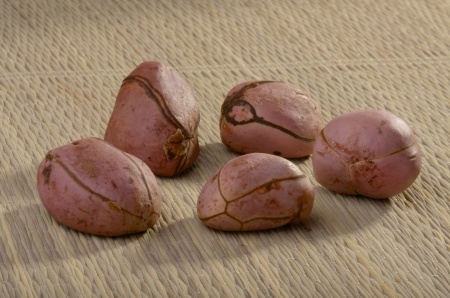Kola Nut - Cola acuminata

Common Names: Kola Nut, Cola Nut, Bissy, Gurru Nuts, Cola acuminata, Kola, Cola, Global, English, Latin
Latin Name: Cola acuminata
Origin: Africa, Asia, South America, North America
Short Introduction
Cultivating the Kola tree comes with many variables. There is a considerable (and quite common) risk of low seed germination and variable fruit yield among individual trees. A highly productive tree may grow right next to a very unproductive one. This variability can be a challenge even in favorable growing conditions. It is not possible (and there are no cases to the contrary) to cultivate Kola trees in the temperate climate of the Czech Republic—very specific conditions would be needed and even then, the benefits of growing the plant cannot be guaranteed.
Detailed Description
A plant that invigorates both body and mind. Natural stimulant.
Botanical Information
Kola Nut, scientifically known as Cola acuminata, is a slender tree that can reach heights of up to 20 meters. With a spreading and robust crown, it resembles the horse chestnut. Its leaves are oval, leathery on both sides, reaching up to 20 cm in length and 5–7 cm in width. The leaf blade is wavy and curled, and the petiole is several centimeters long. The flowers can be either unisexual or bisexual, white in color, and gathered in racemose clusters. The fruit of the Kola tree is an elongated follicle up to 20 cm long. Young follicles grow in clusters of five, forming a spherical shape, while mature fruits become brownish. The interior is notably bitter.
Origin and Distribution
Kola seeds are still used as a form of currency in some parts of Africa. They are considered sacred by many Muslims and treated with great respect. Native to Central and West Africa, Kola trees thrive in the deep rainforests of these regions. Today, they are cultivated primarily in Nigeria, Sudan, and the Americas, with the most successful growth in Mexico, Jamaica, and Brazil. The tree is also found in South Asia and tropical regions of India.
Usage / Dosage
Kola seeds have been marketed since the 19th century, most famously when John Pemberton introduced a wine-based beverage containing extracts from coca and the Kola tree—an early precursor to what became Coca-Cola after soda was added during American Prohibition. Another important milestone in Kola’s commercial history was the invention of the German energy chocolate Scho-ka-kola, first produced in 1935 and still available today.
Kola Nut has played a significant role in the pharmaceutical industry, where it is used in the production of stimulant preparations (such as cola wine, tablets, and capsules). The food industry uses it to make refreshing beverages. In traditional African medicine, it is sought after for its energizing effect, helping with fatigue, loss of energy, and melancholy. In West Africa, Kola Nuts are prescribed for erectile dysfunction and mental health issues (including depression, anxiety, and frustration). The nuts can be roasted, chewed, or added to drinks like tea, milk, or coffee. Kola’s stimulating properties are now appreciated worldwide.
The fruit contains about 2–3% caffeine and other related alkaloids that boost the effect of caffeine. Caffeine acts as a diuretic (promoting urine production, so maintaining proper hydration is recommended), temporarily increases alertness, and stimulates the nervous system. The tannin content contributes to its use for relieving diarrhea and digestive issues, acting similarly to a natural disinfectant.
Its starchy content helps suppress thirst and provides a gentle stimulation of the central nervous system. In African tradition, Kola Nuts have been (and still are) recommended for quenching thirst and hunger as well as easing pain. Many modern combination painkillers include caffeine to enhance pain relief and improve the kinetics of the medication.
Kola Nuts have been used to restore lost vitality, improve zest for life, combat fatigue of any kind, and as an aphrodisiac. Thanks to their high caffeine content, Cola acuminata is studied for its role in weight management and appetite control. Caffeine alone appears to increase heart rate and promote energy expenditure and fat burning, which in combination (especially with exercise) may contribute to weight loss or the management of excess body weight.
Active Compounds
The key active compounds are alkaloids, most notably caffeine, theobromine, and theophylline. Other important constituents include tannins (such as tannin and other phenolic compounds), essential oils, and a substantial amount of starch.
Traditional Dosage
The most common commercially available form of Cola acuminata is powder. The recommended dosage is generally 2 to 6 grams, stirred into a beverage (either warm or at room temperature). Do not exceed the recommended amount to minimize risk of insomnia or restlessness. Due to the high caffeine content, Cola acuminata is not suitable for pregnant or breastfeeding women or for children.
